Red Trillium, Trillium erectum, is a beautiful plant blooming in spring. This herbaceous perennial plant is native to the forests of eastern North America. Other common names include: red wake robin, purple trillium and stinking benjamin.
Flowers
Flowers:
Red Trillium, Trillium erectum, like other trilliums has flower parts of 3 or multiples of 3. The flower has 3 petals, 3 sepals, 3 distinct stigmas, 6 stamens and a whorl of 3 leaves just below the flower. The deep red/maroon flower is about 2 inches across. The maroon petals are straight-margined. The petals and sepals are lanceolate to ovate and hairless and about the same length. The sepals are much narrower than the petals. The sepals and petals open widely and are in the same plane.
Stamens: The filaments are short and the anthers are long. The anthers are reddish between the pollen sacs. The anthers (pollen sacs) dehisce introrsely (release pollen toward the center of the flower). The pollen is whitish yellow.
Pistil: The ovary is globose and dark red or black. The pistil is the fusion of 3 carpels, each carpel has an ovary, (style), and stigma. The fused 3 carpel ovaries result in an ovary with 6 ridges. The 3 carpel stigmas do not fuse so there are 3 distinct stigmas (not connected at the base). The 3 stigmas are wider at the base and narrows to the tip and reflexes (bends backwards). A stigma emerges at the apex of two ridges.
Trillium offers pollen.
Flower with its 3 petals, 3 narrow sepals and its whorl of 3 leaves below it.
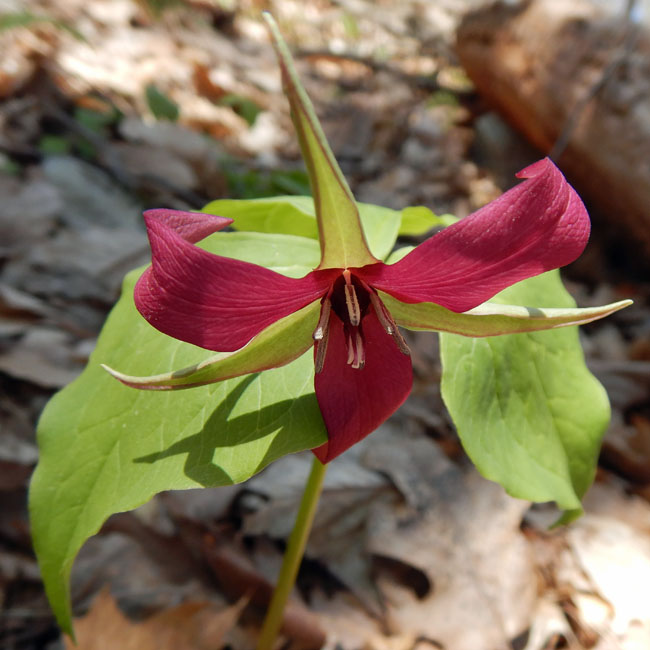
The petals of this flower are broader. Sometimes the sepals have red streaks.
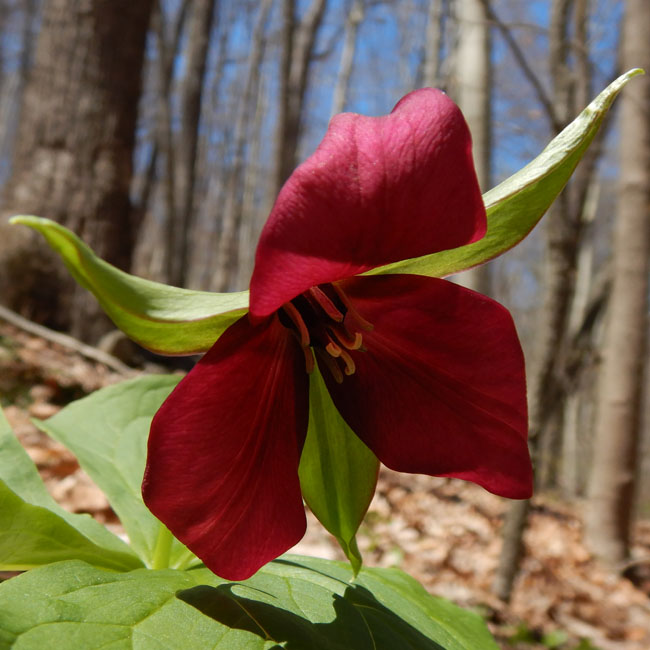
Flower closeup:
6 stamens: filaments short, hard to see; between the anther sacs is reddish, more on the back (facing away from the center) than on the front (facing the center because the pollen is release toward (introrsely) the center; anther sacs - pollen whitish.
pistil: large rounded ridged dark maroon ovary; 3 distinct stigmas extend from the ovary ridges; stigmas are wide at the base and tapper gradually and become recurved; back side is maroon and the stigmatic surface is whitish.
In the photos, some of the anthers and stigmas are lit through the petals so they do not appear whitish.
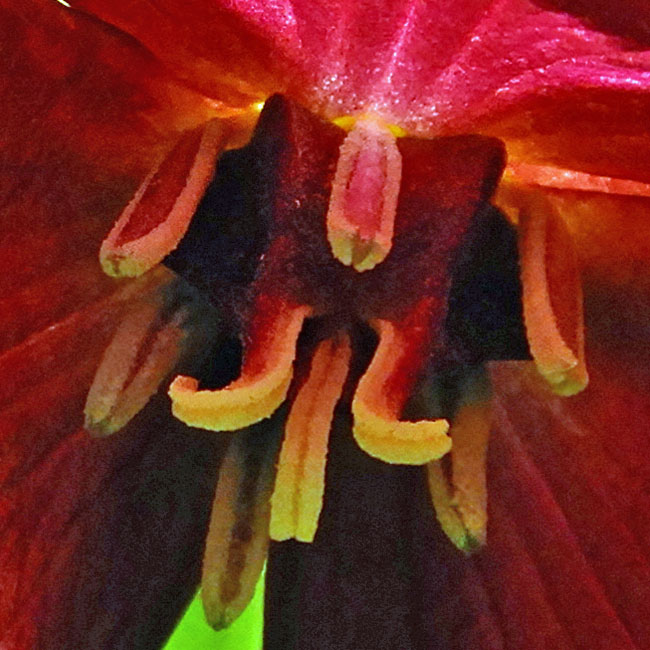
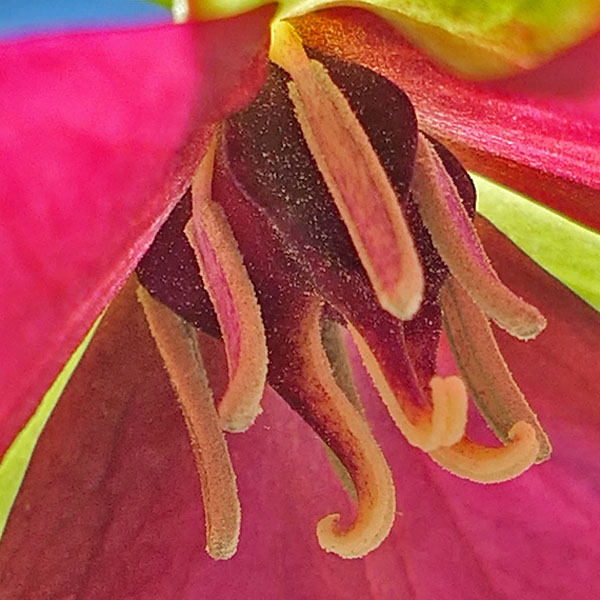
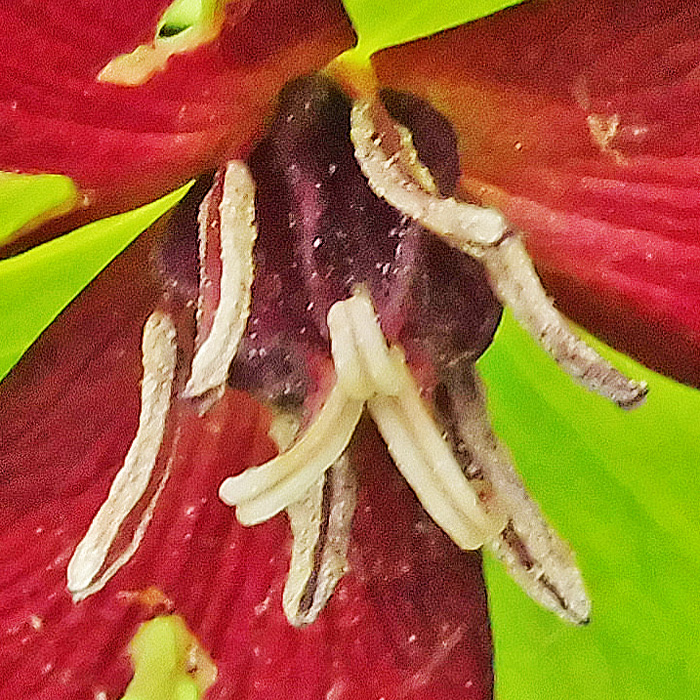
Pedicel (flower stalk from leaves to flower): arises from the center of the whorl of leaves; about 2 inches long; erect; slightly bent; flower may be slightly nodding but always above the whorl of leaves
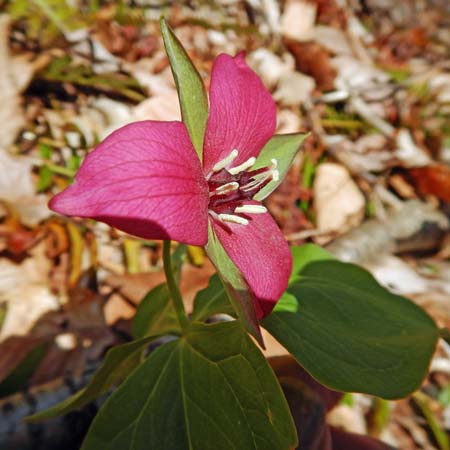
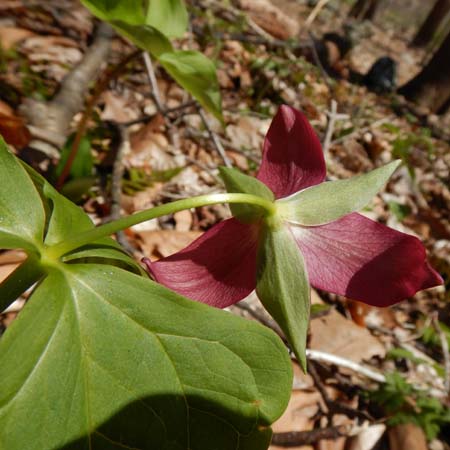
Fruit
Fruit:
The fruit is maroon, 6 angled, roundish and about 1/2 inch long and wide.
The photos show the 6 ridges but they are not evenly spaced, the wide spaces alternate with narrower spaces. At the end of the narrower-spaced ridges is the remains of a stigma.
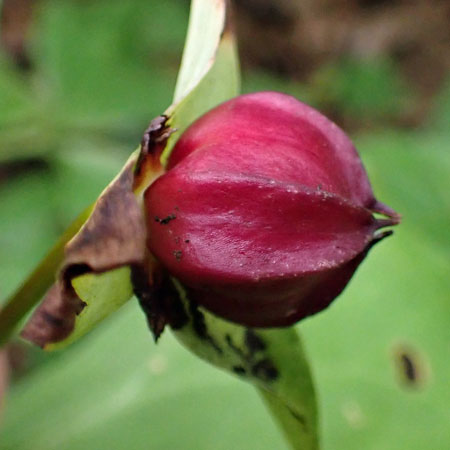
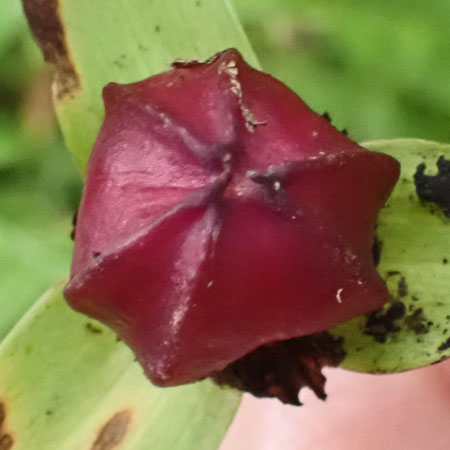
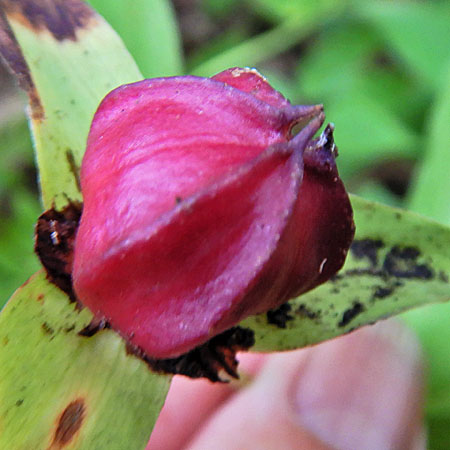
Like many spring flowers, the trillium seeds have attachments called elaiosomes that are high energy food for the ants. Ants carry the seeds back to their nest, eat the elaiosomes, and discard the seeds in their waste area where the seeds will eventually germinate. This is called myrmecochory.
Leaves
Leaves:
The whorl of 3 leaves just below the flowers are technically bracts. Some literature refer to them as leaves and others as bracts. They are sessile and up to 8 inches wide and long. They are as wide as they are long. The leaves are broadly rhombic (diamond) shaped, broadest near the middle. The second photo below, the plant is in the 3 leaf stage without a flower.
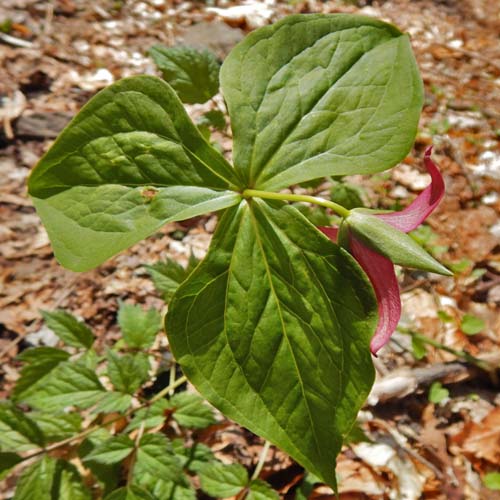
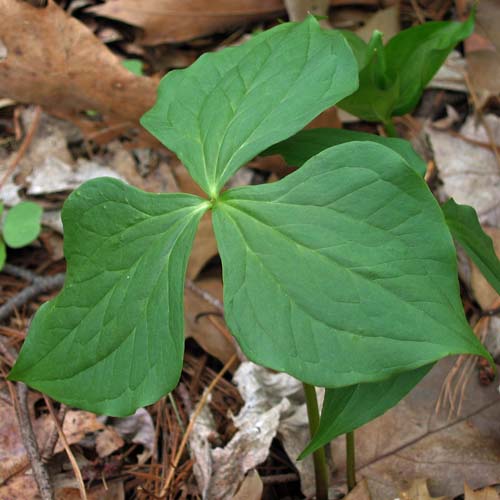
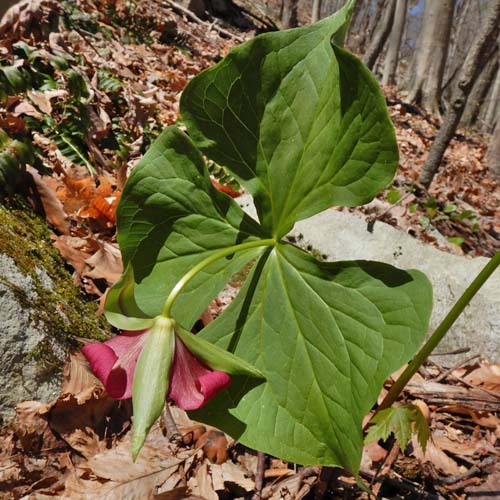
Plant & Habitat
The Red Trillium plant has one unbranched stalk which is topped by the single terminal flower just above a 3-leaf whorl. The plant can be 15 inches tall or more. The stalk emerges from a short thick rhizome which is a specialized underground horizontal stem. Interestingly the flower stalk is technically an extension of the rhizome and is termed a scape in some of the literature.
Red trillium has a noticeable unpleasant odor which gives it the common name - stinking benjamin.
Young plant with flower bud.
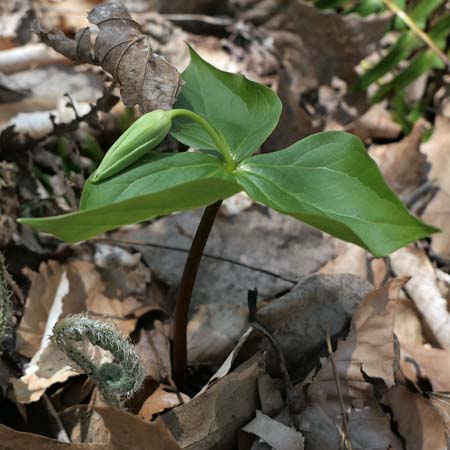
Plants growing on hillside.
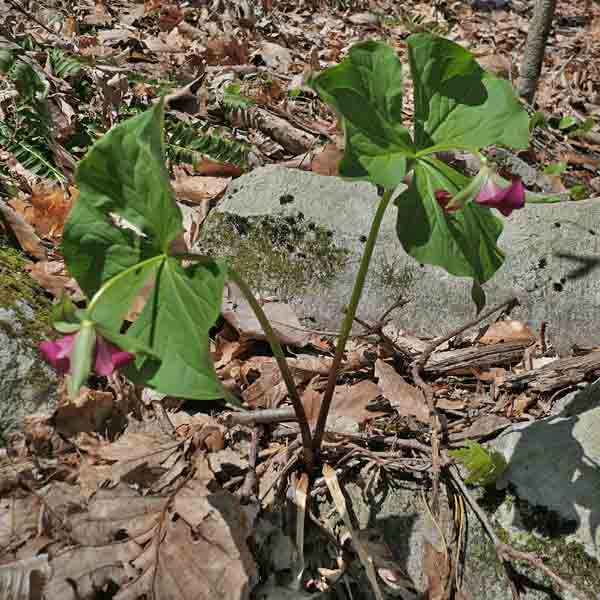
The red trillium blooms early spring. The habitats include rich moist woods.
Trillium life cycle: Trilliums are known to take years to bloom starting from seed going through several stages. (See great white trillium.)
There are two varieties of red trillium, both plants are the same except for petal color:
- red petals: Trillium erectum var. erectum
- white petals: Trillium erectum var. album
Rarity: In NJ, the Red Trillium is S3 (Vulnerable). Globally it is secure, G5.
There are 43 species of Trillium world wide, 38 are in North America mostly in the eastern states. New Jersey has only 4. The 4 NJ native trilliums are:
- T. erectum (red trillium)
- T. cernuum (nodding trillium)
- T. grandiflorum (great white trillium)
- T. undulatum (painted trillium)
Weakley's key to the Trilliums. It is interesting to see the features that separate the species. Weakley's key is limited to the Southern NJ and the Southeast so that there are fewer plants but large enough coverage to include other trilliums you may come across. This in turn, makes the key simpler than a key that covers all North America.
For Trillium erectum:
- Flowers are pedicellate - stalk between flower and whorl of leaves (vs. sessile - no stalk)
- Petals relatively thick in texture, straight-margined; stigmas thicker at base, tapering gradually toward tip, distinct; ovary purple-black, maroon, pink, or white; [Erectum group] Key B (vs delicate texture, wavy margined; stigmas thin, uniform in thickness from base to apex, somewhat fused at the base; ovary greenish white)
- Flowers held at or above the level of the leaves (vs. below the leaves)
- Ovary globose, widest near the middle, black to purplish black (vs. ovary flask-shaped, broadest near the base, usually white to pinkish)
- Petals lanceolate to narrowly ovate (wider at base) or elliptic (widest at middle), spreading from base in the same plane as the sepals; flower fragrance unpleasant
Text by Millie Ling and all photos by Hubert & Millie Ling. Photos: cultivation, preserve in Morris County: end of April, early May; fruit in August. We found the red and white varieties growing together in almost the same quantities.
Additional information / References
Additional information / references:
- Flora of North America: Trillium erectum https://floranorthamerica.org/Trillium_erectum
- USDA Forest Service Plant of the Week: Trillium erectum https://www.fs.usda.gov/wildflowers/plant-of-the-week/trillium_erectum.shtml
- Illinois Wildflowers Trillium erectum https://www.illinoiswildflowers.info/woodland/plants/red_trillium.html
- Weakley: Flora of the Southern and Mid-Atlantic States: key to trilliums, pg 164: downloadable, https://ncbg.unc.edu/wp-content/uploads/sites/963/2019/04/WeakleyFlora_2015-05-29.pdf
- NatureServe: Trillium erectum https://explorer.natureserve.org/Taxon/ELEMENT_GLOBAL.2.131400/Trillium_erectum